Whenever you want, you can play at being Mad Max. The task only requires closing your eyes, powering up the Gas-Free And Violent Post-Apocalyptic Dystopia program in your mental holodeck, then delivering a few lines in your best early Mel Gibson monotone like, "I think we've got some hoon trouble." or "I'm just here for the gasoline."
What is King of the Hammers? The fact-sheet says it's a 184-mile race through desert and rocks, but the fact sheet can't express the experience. King of the Hammers is a one-day race that combines desert racing at triple-digit speeds, rock racing at double-digit speeds and rock crawling at low single-digit speeds. It comes after a week of vicious, timed punishments for every other kind of vehicle that can blast over barrens and crawl through quarries. It is an endurance test that gives competitors 14 hours to finish before time is called – and even then there's a good chance less than a third of the 120 runners will make it. It has been called one of the hardest races in the world, numerous times. Every year, something like 30,000 people erect a pop-up hamlet called Hammertown for a week to watch it all go down.
More accurately, it is insanity and absurdity that characterizes the best kinds of personal challenges. Even more accurately, it is Thunderdome. And the question that hundreds of off-road racers ask themselves every year, hoping for a chance to just finish – and be stranded in the desert for hours while doing so – is "Thunderdome. How do I get in there?"
Follow us. We'll show you the way.


Even those well beyond the sphere of off-road racing usually know about Dakar and the Baja 1,000 – the custom chassis' built by manufacturer race teams and trophy truck headliners put on shows at 120 miles per hour over terrain that would tear your car apart if you tried to do it at 12 mph. At the other end of velocity, most of us are aware of rock crawling, with lifted Jeeps on giant tires and insect-like articulating axles wading through fields of granite at the speed of sloths, and making a lot of noise doing it.
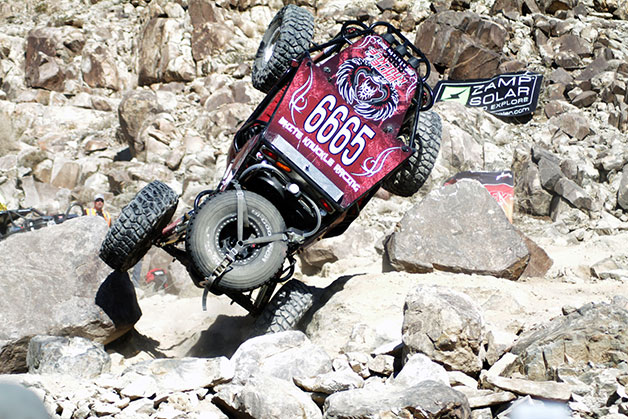
The King of the Hammers occupies the space between the two, putting desert racing, rock racing and rock crawling into one challenge, and for that reason alone it is like no other race in the world and could be the toughest one-day challenge on the planet. To even finish it, much less win, you need a vehicle that can do something like 100 mph or more through the desert and that can also get through boulder fields that would make Venutians weep.
Hammertown sits on the Means Dry Lake Bed in the Johnson OHV Recreational area, and coming upon it at night is like heading into one of those government encampments from the X-Files, where the feds sets up camp while they investigate alien phenomena. And that's an apt parallel because there's nothing on Earth like King of the Hammers, as we found out over four days of desert living and as were told every day by everyone there.
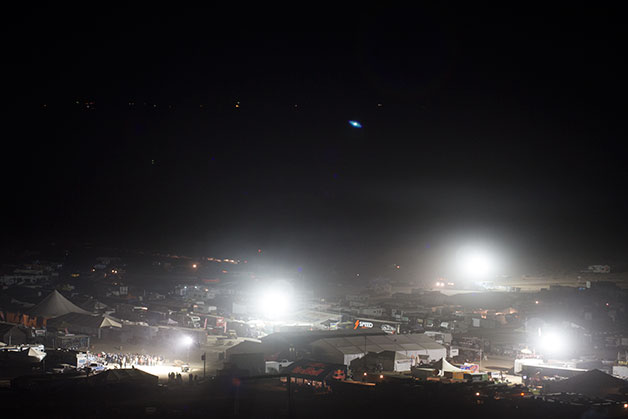
Even in the dark, Hammertown explodes with the bellows of small-block engines located in the fronts and backs of Jeeps, Toyotas, Chevys and tube-framed chassis'. The Johnson OHV area is hugely popular with off-roaders, and with enough lights on your rig there's no reason the action has to end just because the day has. Well into the night – while weather-proofed spectators enjoy show – they run the rock gullies in the area collectively called 'the hammers' – like Jackhammer, Clawhammer and Sledge, along with other redoubts like Chocolate Thunder, Back Door, Resolution, Outer Limits and Big Johnson.
The result, the very next year, was the first King of the Hammers. All of 12 people showed up, and they had to be hoodwinked into it – Cole had no money to promote his race or even give people a reason to show up to compete, so he called anyone who expressed interest and said, "Everyone else is in, but I can get you in if you get me your entry fee today."
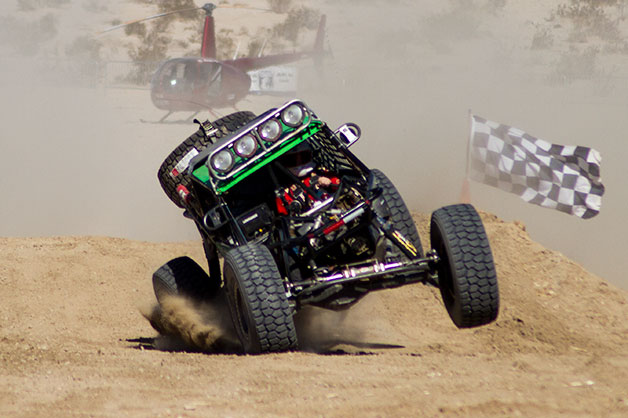
That sandy dozen are now called "The O.G. 13" because of a mistake when the commemorative shirts were printed, and the 12 of them have a permanent invitation to run without having to qualify for the race. At the time, though, when they made up a field smaller than a grocery store line and Cole told them "You guys will never have to qualify," their first question was, "What do you mean, 'qualify?'"
For the next two years, as a way to manufacture exclusivity, the race was invite-only but it took everyone who made a legitimate effort to give reasons to compete. In 2009 – just two years after 12 entrants showed up – qualifying was introduced, called "LCQ" for Last Chance Qualifiers. "If you had an invite but we didn't think you were ready," Cole said, "you could come and try to qualify."
What else makes King of the Hammers special? Said Cole, "I won a world championship in rock crawling and I got a check for $1,300. I thought that was ridiculous. I also thought desert racing was broken – at the time the entry fee for Baja was $3,700, but you could win in a trophy truck and you'd get a check for $3,200. You wouldn't even make your entry fee back."

It costs $1,400 to enter King of the Hammers. If you get into LCQ (which is first come, first served) you pay $400, the balance due only if you qualify for the race. If you win King of the Hammers you get $25,000, while second place makes $5,000 and third makes $2,500. When a race-winning car might only cost $90,000, that's a nice pile of dubloons.
The lure of the race itself and what it means for off-road racing – a single challenge that tackles every kind of desert competition there is – is now attracting big names from big races, like trophy truck drivers Robby Gordon and BJ Baldwin.
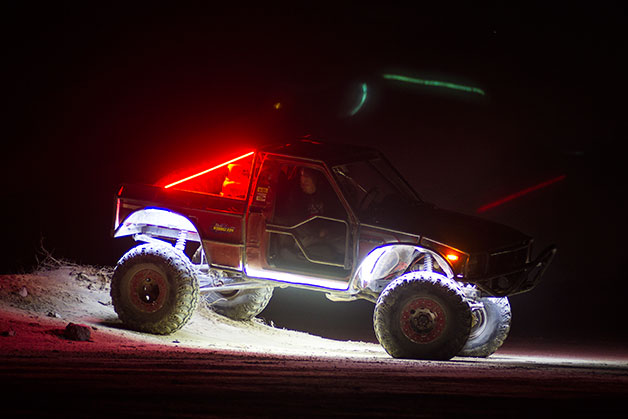
Baldwin, who has his own Baldwin Motorsports team for trophy truck racing, was at King of the Hammers for the first time. He's been in desert racing for 15 years and has won five trophy truck championships as well as the Baja 500 and Baja 1,000. On seeing what he was in for in the Johnson Valley, "I was [expletive] blown away," he said. "The cars are amazing. This is the Baja 1,000 and Daytona 24 Hour of off-road racing. I really don't think it gets the respect it deserves." he said. Riding shotgun with another driver, Baldwin said "we got to a wall I said 'There's no way you're getting up that without a helicopter.'" Asked what happened, he said, "The guy did it no problem."
Having qualified 29th for the race, he said, "Usually I'm the [expletive], but I haven't felt like this, having to learn something totally new, in 15 years."
The rocks can also play equalizer, keeping just anyone with a bunch of money and a good truck from dominating the race. Said Baldwin, "It's weird to think about not having as much power as possible, but here a guy with a small motor can compete with guys with big motors and big horsepower – it might just be down to how drivable the thing is or how good he is through the rocks."
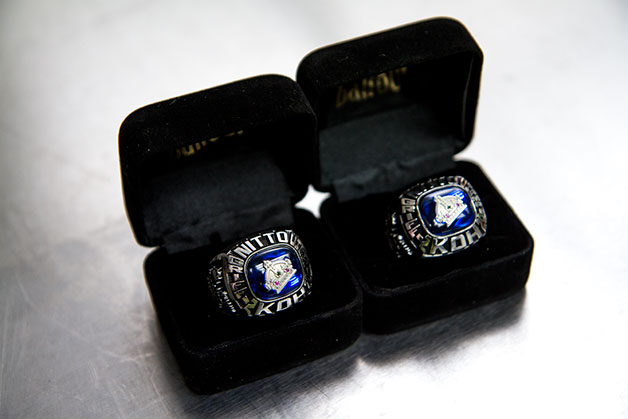
On the other hand, there are the old hands at rock crawling. Griffin Radiators is the title sponsor of the race, Nitto Tire the presenting sponsor, and Nitto has built a tire just for the demands of King of the Hammers and Ultra 4 Racing. Tim Coltey, Nitto's marketing specialist, would go to King of the Hammers every year on his own and kept presenting it to the president of the company until he was finally given the go-ahead to get involved.
One of Nitto's sponsored drivers is Derek West, a world-championship-winning rock crawler and rock racer who started with his wife's Jeep when it was her daily driver at the time. He's done KotH four times, finishing in fourth last year and in third two years before that – 90 seconds behind second place after seven hours of racing.
His philosophy was that, like triathlons, you choose where you're good and limit damage elsewhere. "We excel at going fast in rock sections and making rock climbs," he said, and since "There are more rocks in this race than in any race on Earth, ever," that focus could come in handy.
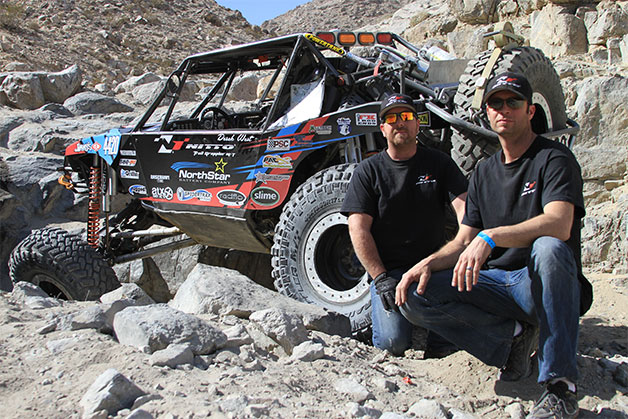
When it comes to those rocks, though, some of the competitors create obstacles as bad as the terrain. "The biggest problem with some other drivers is they can't make it, and they try 50 times and then the 51st time they break." When the lane gets so narrow that only one guy can get through, West says you have to figure out which choice to make to get the obstacle out of the way because the guy behind you is bearing down. "I'm gonna come up on guys stuck and blowing apart, and then I can find another line, I can chill and wait, my co-driver might help them, I can winch them or I can drive over them."
In the desert sections, however, getting slow-movers out of the way is a bit easier: "I don't want to hit anyone, but we built a special front bumper to move people, it's called The Motivator. We call it 'Beep Beep Bump.'"
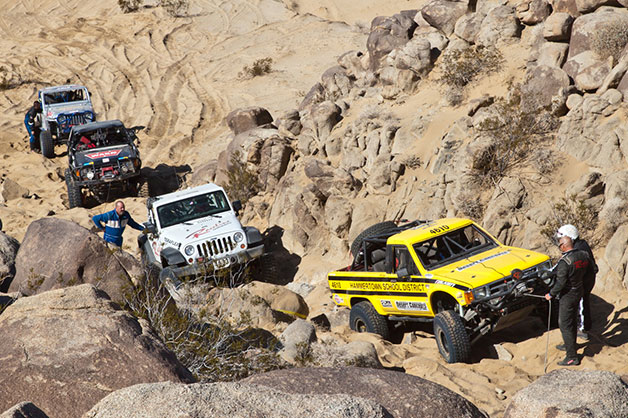
Race strategy also plays a part: During the three laps of the race, a miserably difficult rock section called Back Door that can easily end your race has to be done once on any lap the driver chooses. West said he thought the desert guys, the trophy truck guys, would save it for the last lap because "They want to lead the race – they want to hang their nuts out in the desert to show how big they are." West, who qualified tenth, was planning to do it on the first lap, figuring it would be free of other competitors and broken down cars on the first lap. We rode along with West up Back Door in his rig, and it's no joke – it took us three tries to make it over the waterfall, but he did it behind the driver's seat and not with us in front of the winch.
Still, no one thinks any strategy or anything else is guaranteed with King of the Hammers. We have never heard so many competitors say, "First, we just have to finish." When we asked West's co-driver, Henne, how much luck he thought was involved in just finishing the race, he said "50 percent," and West agreed.
That's unheard of. Well, unless you're at King of the Hammers.
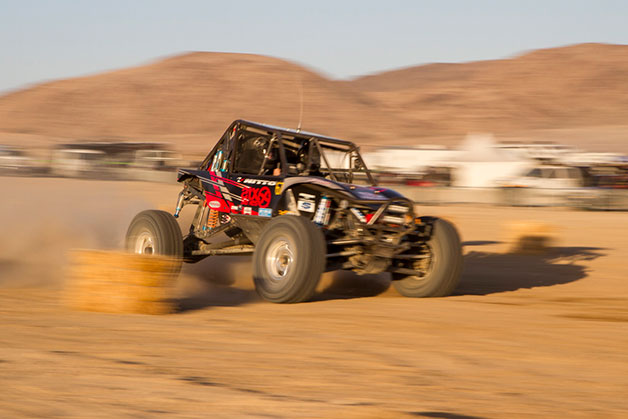
That's our report for now. We'll be back tomorrow with the race recap and a look at what happens when you spend four days in the desert at the end of the world.
Or you can be Mad Max. We've been to a lot of places and a lot of races in the world where you can approach the fantasy, but to go all the way – to a place where asking "When is Humungus coming back?" and "Where can I find Master Blaster?" wouldn't feel strange at all – you need to roll down onto the Means Dry Lake Bed in Johnson Valley, California for King of the Hammers.It has been called one of the hardest races in the world, numerous times.
What is King of the Hammers? The fact-sheet says it's a 184-mile race through desert and rocks, but the fact sheet can't express the experience. King of the Hammers is a one-day race that combines desert racing at triple-digit speeds, rock racing at double-digit speeds and rock crawling at low single-digit speeds. It comes after a week of vicious, timed punishments for every other kind of vehicle that can blast over barrens and crawl through quarries. It is an endurance test that gives competitors 14 hours to finish before time is called – and even then there's a good chance less than a third of the 120 runners will make it. It has been called one of the hardest races in the world, numerous times. Every year, something like 30,000 people erect a pop-up hamlet called Hammertown for a week to watch it all go down.
More accurately, it is insanity and absurdity that characterizes the best kinds of personal challenges. Even more accurately, it is Thunderdome. And the question that hundreds of off-road racers ask themselves every year, hoping for a chance to just finish – and be stranded in the desert for hours while doing so – is "Thunderdome. How do I get in there?"
Follow us. We'll show you the way.


Even those well beyond the sphere of off-road racing usually know about Dakar and the Baja 1,000 – the custom chassis' built by manufacturer race teams and trophy truck headliners put on shows at 120 miles per hour over terrain that would tear your car apart if you tried to do it at 12 mph. At the other end of velocity, most of us are aware of rock crawling, with lifted Jeeps on giant tires and insect-like articulating axles wading through fields of granite at the speed of sloths, and making a lot of noise doing it.

The King of the Hammers occupies the space between the two, putting desert racing, rock racing and rock crawling into one challenge, and for that reason alone it is like no other race in the world and could be the toughest one-day challenge on the planet. To even finish it, much less win, you need a vehicle that can do something like 100 mph or more through the desert and that can also get through boulder fields that would make Venutians weep.
We descended into Hammertown on a Tuesday evening, the GPS pointing out a left onto Boone Road of "downtown" Landers. Booone Road is a dirt track that we would have missed if there hadn't been another vehicle in front of us also headed to Hammertown, and the population of "downtown" Landers is normally only hares, insects and tumbleweeds.The King of the Hammers puts desert racing, rock racing and rock crawling into one challenge
Hammertown sits on the Means Dry Lake Bed in the Johnson OHV Recreational area, and coming upon it at night is like heading into one of those government encampments from the X-Files, where the feds sets up camp while they investigate alien phenomena. And that's an apt parallel because there's nothing on Earth like King of the Hammers, as we found out over four days of desert living and as were told every day by everyone there.

Even in the dark, Hammertown explodes with the bellows of small-block engines located in the fronts and backs of Jeeps, Toyotas, Chevys and tube-framed chassis'. The Johnson OHV area is hugely popular with off-roaders, and with enough lights on your rig there's no reason the action has to end just because the day has. Well into the night – while weather-proofed spectators enjoy show – they run the rock gullies in the area collectively called 'the hammers' – like Jackhammer, Clawhammer and Sledge, along with other redoubts like Chocolate Thunder, Back Door, Resolution, Outer Limits and Big Johnson.
The scene is presided over by one man: Dave Cole. The exact opposite of an impresario like Bernie Ecclestone in Formula One, Cole established the template for the kinds of people we'd meet all week: the nicest, most genuine and plain-spoken people you've ever had the pleasure of talking to. Along with former partner Jeff Knoll, in 2006 Cole got the idea to link all the 'hammer' trails together and run it as a race.The scene is presided over by one man: Dave Cole.
The result, the very next year, was the first King of the Hammers. All of 12 people showed up, and they had to be hoodwinked into it – Cole had no money to promote his race or even give people a reason to show up to compete, so he called anyone who expressed interest and said, "Everyone else is in, but I can get you in if you get me your entry fee today."

That sandy dozen are now called "The O.G. 13" because of a mistake when the commemorative shirts were printed, and the 12 of them have a permanent invitation to run without having to qualify for the race. At the time, though, when they made up a field smaller than a grocery store line and Cole told them "You guys will never have to qualify," their first question was, "What do you mean, 'qualify?'"
For the next two years, as a way to manufacture exclusivity, the race was invite-only but it took everyone who made a legitimate effort to give reasons to compete. In 2009 – just two years after 12 entrants showed up – qualifying was introduced, called "LCQ" for Last Chance Qualifiers. "If you had an invite but we didn't think you were ready," Cole said, "you could come and try to qualify."
Four years later, whether or not you've heard of it, the race is now officially Big Time. In seven years the race has gone from 12 drivers to a field capped at 120, and it's filled only after a lot of drivers don't make it; there are 110 invited and another 10 places filled by the LCQ. As for those invites, an entire, year-long racing series called Ultra4 Racing was created to select them and Ultra 4 Racing has now begun hosting races overseas. Instead of just 12 drivers, drivers from 12 countries showed up for this year's race. A further 60 racers are invited to run LCQ, but only 10 will make it – and the LCQ field is also full. What was a one-day race is now a week of events and races like King of the Motos and the Smittybilt Everyman Challenge for stock vehicles. Something like 30,000 people show up for the big race and watch two jumbotrons and live feeds from the event in Hammertown, while nearly half a million people will watch the week's racing live-streamed online. Hammertown has a volunteer squad of professional firefighters that use the week for their extreme training exercises.Instead of just 12 drivers, drivers from 12 countries showed up for this year's race.
What else makes King of the Hammers special? Said Cole, "I won a world championship in rock crawling and I got a check for $1,300. I thought that was ridiculous. I also thought desert racing was broken – at the time the entry fee for Baja was $3,700, but you could win in a trophy truck and you'd get a check for $3,200. You wouldn't even make your entry fee back."

It costs $1,400 to enter King of the Hammers. If you get into LCQ (which is first come, first served) you pay $400, the balance due only if you qualify for the race. If you win King of the Hammers you get $25,000, while second place makes $5,000 and third makes $2,500. When a race-winning car might only cost $90,000, that's a nice pile of dubloons.
Yet perhaps the best thing about KotH, especially for those us watching road racing series' incorporate more spec elements, is that KotH is "It's truly unlimited racing," Cole said. "You can do anything you want – supercharged, turbocharged, LS7, electric, I don't care. Anything you want to do."The lure of the race itself and what it means for off-road racing is now attracting big names like Robby Gordon.
The lure of the race itself and what it means for off-road racing – a single challenge that tackles every kind of desert competition there is – is now attracting big names from big races, like trophy truck drivers Robby Gordon and BJ Baldwin.

Baldwin, who has his own Baldwin Motorsports team for trophy truck racing, was at King of the Hammers for the first time. He's been in desert racing for 15 years and has won five trophy truck championships as well as the Baja 500 and Baja 1,000. On seeing what he was in for in the Johnson Valley, "I was [expletive] blown away," he said. "The cars are amazing. This is the Baja 1,000 and Daytona 24 Hour of off-road racing. I really don't think it gets the respect it deserves." he said. Riding shotgun with another driver, Baldwin said "we got to a wall I said 'There's no way you're getting up that without a helicopter.'" Asked what happened, he said, "The guy did it no problem."
Doing 130 mph across the desert in his trophy truck might sound totally unlike doing 4 mph through boulders, but Baldwin says it does have one thing in common. "It doesn't seem that impressive until you see it. When I'm going 3 or 4 mph through the rocks it's the same focus I need to do 130 – you have to be on point or else you'll end up upside down. I try to have a lot of finesse with my truck, but these guys bounce off huge rocks and drive over the top of each other. They don't quite have the tech of trophy trucks, but the skill level it takes to get through the rocks is equal to the skill you need to drive a trophy truck.""The skill level it takes to get through the rocks is equal to the skill you need to drive a trophy truck."
Having qualified 29th for the race, he said, "Usually I'm the [expletive], but I haven't felt like this, having to learn something totally new, in 15 years."
The rocks can also play equalizer, keeping just anyone with a bunch of money and a good truck from dominating the race. Said Baldwin, "It's weird to think about not having as much power as possible, but here a guy with a small motor can compete with guys with big motors and big horsepower – it might just be down to how drivable the thing is or how good he is through the rocks."

On the other hand, there are the old hands at rock crawling. Griffin Radiators is the title sponsor of the race, Nitto Tire the presenting sponsor, and Nitto has built a tire just for the demands of King of the Hammers and Ultra 4 Racing. Tim Coltey, Nitto's marketing specialist, would go to King of the Hammers every year on his own and kept presenting it to the president of the company until he was finally given the go-ahead to get involved.
Nitto is there for the same reason that a small city erupts in the desert every year: "There is no other race like this in the world, and we believe this is the toughest race in the world."Nitto has built a tire just for the demands of King of the Hammers.
One of Nitto's sponsored drivers is Derek West, a world-championship-winning rock crawler and rock racer who started with his wife's Jeep when it was her daily driver at the time. He's done KotH four times, finishing in fourth last year and in third two years before that – 90 seconds behind second place after seven hours of racing.
His philosophy was that, like triathlons, you choose where you're good and limit damage elsewhere. "We excel at going fast in rock sections and making rock climbs," he said, and since "There are more rocks in this race than in any race on Earth, ever," that focus could come in handy.

When it comes to those rocks, though, some of the competitors create obstacles as bad as the terrain. "The biggest problem with some other drivers is they can't make it, and they try 50 times and then the 51st time they break." When the lane gets so narrow that only one guy can get through, West says you have to figure out which choice to make to get the obstacle out of the way because the guy behind you is bearing down. "I'm gonna come up on guys stuck and blowing apart, and then I can find another line, I can chill and wait, my co-driver might help them, I can winch them or I can drive over them."
In the desert sections, however, getting slow-movers out of the way is a bit easier: "I don't want to hit anyone, but we built a special front bumper to move people, it's called The Motivator. We call it 'Beep Beep Bump.'"

Race strategy also plays a part: During the three laps of the race, a miserably difficult rock section called Back Door that can easily end your race has to be done once on any lap the driver chooses. West said he thought the desert guys, the trophy truck guys, would save it for the last lap because "They want to lead the race – they want to hang their nuts out in the desert to show how big they are." West, who qualified tenth, was planning to do it on the first lap, figuring it would be free of other competitors and broken down cars on the first lap. We rode along with West up Back Door in his rig, and it's no joke – it took us three tries to make it over the waterfall, but he did it behind the driver's seat and not with us in front of the winch.
Still, no one thinks any strategy or anything else is guaranteed with King of the Hammers. We have never heard so many competitors say, "First, we just have to finish." When we asked West's co-driver, Henne, how much luck he thought was involved in just finishing the race, he said "50 percent," and West agreed.
That's unheard of. Well, unless you're at King of the Hammers.

That's our report for now. We'll be back tomorrow with the race recap and a look at what happens when you spend four days in the desert at the end of the world.
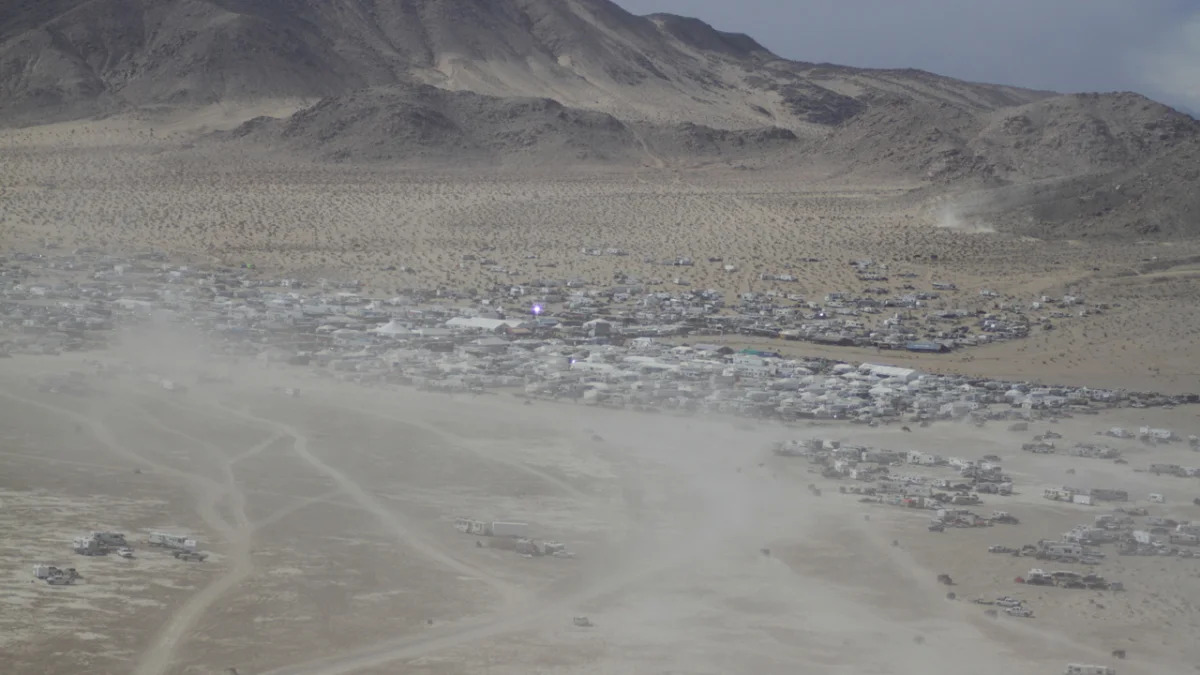









Sign in to post
Please sign in to leave a comment.
Continue